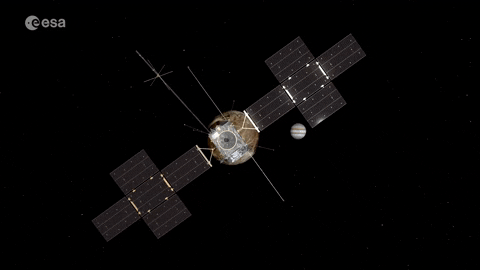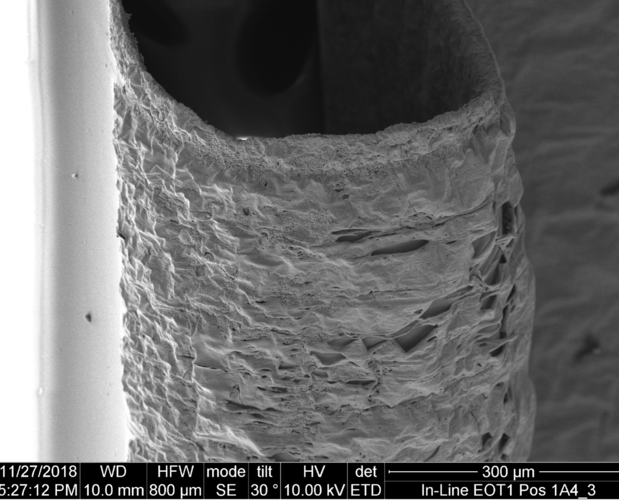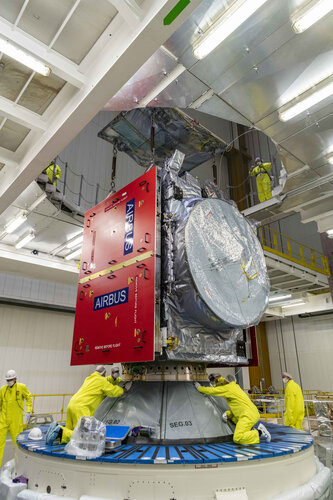
Copernical Team
How Juice was made ready for Jupiter

Deciding to go to Jupiter was the easy part: it’s by far the largest planet around the Sun, resembling a Solar System in its own right with its many moons, three of which may well be home to hidden oceans beneath their icy surfaces. Then came the practical question: how do we actually put together a mission to go there? It was here that ESA’s Directorate of Technology, Engineering and Quality lent its support to the Juice team, tackling numerous technical challenges that threatened to bar Europe’s way to the king of planets.
Juice testing – down to the wire
 Image:
Juice testing – down to the wire
Image:
Juice testing – down to the wire Juice meets Ariane 5

Over the past few days, Juice has been transferred to the final assembly building and mounted onto the Ariane 5 rocket that will carry it into space. These photos capture the key milestones in this process.
Two views of Las Vegas
 These two images show a large part of the city of Las Vegas and parts of its surroundings. One is a true colour representation (left) and one is a false colour representation (right).
The images were acquired by the German environmental satellite EnMAP, which captured a 41-kilometre by 122-kilometre image strip of the region on 12 July 2022. The total area is approximately 5077 square kilo
These two images show a large part of the city of Las Vegas and parts of its surroundings. One is a true colour representation (left) and one is a false colour representation (right).
The images were acquired by the German environmental satellite EnMAP, which captured a 41-kilometre by 122-kilometre image strip of the region on 12 July 2022. The total area is approximately 5077 square kilo Thales Alenia Space wins contracts for IRIDE radar and optical satellites
 Thales Alenia Space, the joint venture between Thales (67%) and Leonardo (33%), has won contracts from the European Space Agency (ESA) to supply a first batch of six small satellites with synthetic aperture radars (SAR) and one satellite based on optical technology for the Italian Earth observation constellation, IRIDE. This innovative new constellation, based on a number of different sensing in
Thales Alenia Space, the joint venture between Thales (67%) and Leonardo (33%), has won contracts from the European Space Agency (ESA) to supply a first batch of six small satellites with synthetic aperture radars (SAR) and one satellite based on optical technology for the Italian Earth observation constellation, IRIDE. This innovative new constellation, based on a number of different sensing in Raytheon Technologies selected by US Navy for anti-ship strike weapon
 Raytheon Technologies has been awarded a contract from the U.S. Navy for phase one of the Hypersonic Air-Launched Offensive Anti-Surface Warfare weapon program, or HALO. HALO is a carrier-based offensive anti-ship strike weapon that supports the U.S. Navy's long range fires strategy.
"The U.S. Navy requires a highly capable and survivable weapon that's adaptable for future relevance," said
Raytheon Technologies has been awarded a contract from the U.S. Navy for phase one of the Hypersonic Air-Launched Offensive Anti-Surface Warfare weapon program, or HALO. HALO is a carrier-based offensive anti-ship strike weapon that supports the U.S. Navy's long range fires strategy.
"The U.S. Navy requires a highly capable and survivable weapon that's adaptable for future relevance," said SBIRS GEO-6 Satellite Transfers to SpOC
 Space Operations Command recently took control of the Space Based Infrared System (SBIRS) Geosynchronous Earth Orbit (GEO) Satellite-6 from
Space Systems Command on March 24, 2023.
"Space Delta 4 and the 2nd Space Warning Squadron are honored to add SBIRS GEO-6 to our repertoire of missile warning and tracking sensors," said Col. Miguel Cruz, Space Delta 4 commander. "Our mission area has
Space Operations Command recently took control of the Space Based Infrared System (SBIRS) Geosynchronous Earth Orbit (GEO) Satellite-6 from
Space Systems Command on March 24, 2023.
"Space Delta 4 and the 2nd Space Warning Squadron are honored to add SBIRS GEO-6 to our repertoire of missile warning and tracking sensors," said Col. Miguel Cruz, Space Delta 4 commander. "Our mission area has National Reconnaissance Office awards contract extension to Kleos
 Kleos Space Inc. (Kleos), subsidiary of Kleos Space S.A. ASX: KSS, a space-powered defense and intelligence technology company, has been awarded the Stage Two option on its current contract with the National Reconnaissance Office (NRO) as part of the Strategic Commercial Enhancements Broad Agency Announcement (SCE BAA) Framework.
The NRO is responsible for maintaining global vigilance in t
Kleos Space Inc. (Kleos), subsidiary of Kleos Space S.A. ASX: KSS, a space-powered defense and intelligence technology company, has been awarded the Stage Two option on its current contract with the National Reconnaissance Office (NRO) as part of the Strategic Commercial Enhancements Broad Agency Announcement (SCE BAA) Framework.
The NRO is responsible for maintaining global vigilance in t Space Development Agency launches Tranche 0 satellites
 The Space Development Agency (SDA) has announced the successful initial launch of Tranche 0 (T0) of the Proliferated Warfighter Space Architecture (PWSA), the Transport and Tracking Layer satellites that will demonstrate the low-latency communication links to support the warfighter with a resilient network of integrated capabilities, including tracking of advanced missile threats, from low-Earth
The Space Development Agency (SDA) has announced the successful initial launch of Tranche 0 (T0) of the Proliferated Warfighter Space Architecture (PWSA), the Transport and Tracking Layer satellites that will demonstrate the low-latency communication links to support the warfighter with a resilient network of integrated capabilities, including tracking of advanced missile threats, from low-Earth Space ISAC stands up operational watch center to keep pace with proliferating threats to space systems
 Space ISAC, its founding board of directors and executive director launched Space ISAC's Operational Watch Center and its initial operational capability today. This is a crucial milestone for Space ISAC, whose executive, operational, and administrative functions are operated by the National Cybersecurity Center (NCC), and the global space industry, as they address the growing threats and vulnera
Space ISAC, its founding board of directors and executive director launched Space ISAC's Operational Watch Center and its initial operational capability today. This is a crucial milestone for Space ISAC, whose executive, operational, and administrative functions are operated by the National Cybersecurity Center (NCC), and the global space industry, as they address the growing threats and vulnera 
